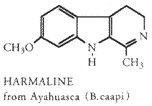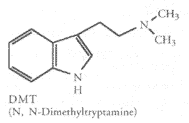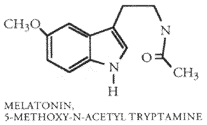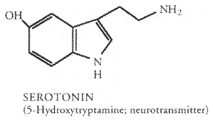A Y A H U A S C A
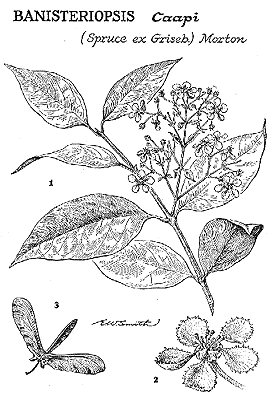 |
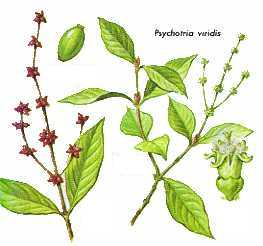 |
| Contains— |
Contains— |
| Resembles— |
Resembles— |
This brew, commonly called yagé, or yajé in Colombia, ayahuasca in Ecuador and Peru (Inca "vine of the dead, vine of the souls," aya means in Quechua "spirit," "ancestor," "dead person," while huasca means "vine," "rope"), and caapi in Brazil, is prepared from segments of a species of the vine
Banisteriopsis, a genus belonging to the Malpighiaceae.1
Sections of vine are boiled with leaves from any of a large number of potential admixture plants (such as Psychotria viridis, pictured above) resulting in a tea that contains the powerful hallucinogenic alkaloids harmine, harmaline, d-tetrahydroharmine, and dimethyltryptamine (DMT). Dimethyltryptamine closely resembles serotonin and has been discovered to be a component of normal mammallian metabolism, an endogenous hallucinogen. These compounds have chemical structures and effects similar, but not identical to LSD, mescaline of the peyote cactus, and psilocybin of the psychotropic Mexican mushroom. This brew has been used in the Amazon for millennia in order to heal, divine, and worship.2
With Ayahuasca, an interior sound is commonly heard, which quite often triggers a spontaneous burst of imitative vocalizings, markedly unlike any conventional human speech or facial contortions. The tryptamines can apparently trigger a kind of rippling of facial muscles, which results in the production of a vocally modulated pressure wave. What is more startling is that the sound, which gains in energy the longer it is sustained, can actually become visible—as if the vibrational wave patterns were shifting into the visible spectrum or inducing a vibrational excitation of the air in such a way as to affect light diffraction. These observations suggest that although the wave is produced with sound, it may possess an electromagnetic component. This peculiar wave phenomenon will continue to be generated out of the mouth and nostrils and will be visible in the surrounding air as long as the vocalizations are continued.3
Natives of Amazon have traditionally combined Banisteriopsis caapi vine, which contains harmine, harmaline and related beta-carbolines, with DMT-containing plants to make an orally active brew called ayahuasca. Other plants containing harmine and/or harmaline can be substituted for B. caapi. The usual 'North-American ayahuasca' consists of Peganum harmala seeds and Desmanthus illinoensis roots, and in Australian 'acaciahuasca' leaves of Acacia complanata are combined with material from DMT-containing acacias (the effectivity of this mixture hasn't been confirmed).4
Assembled from material by 1Harner, 2Luna, 3McKenna, and 4Ott.
